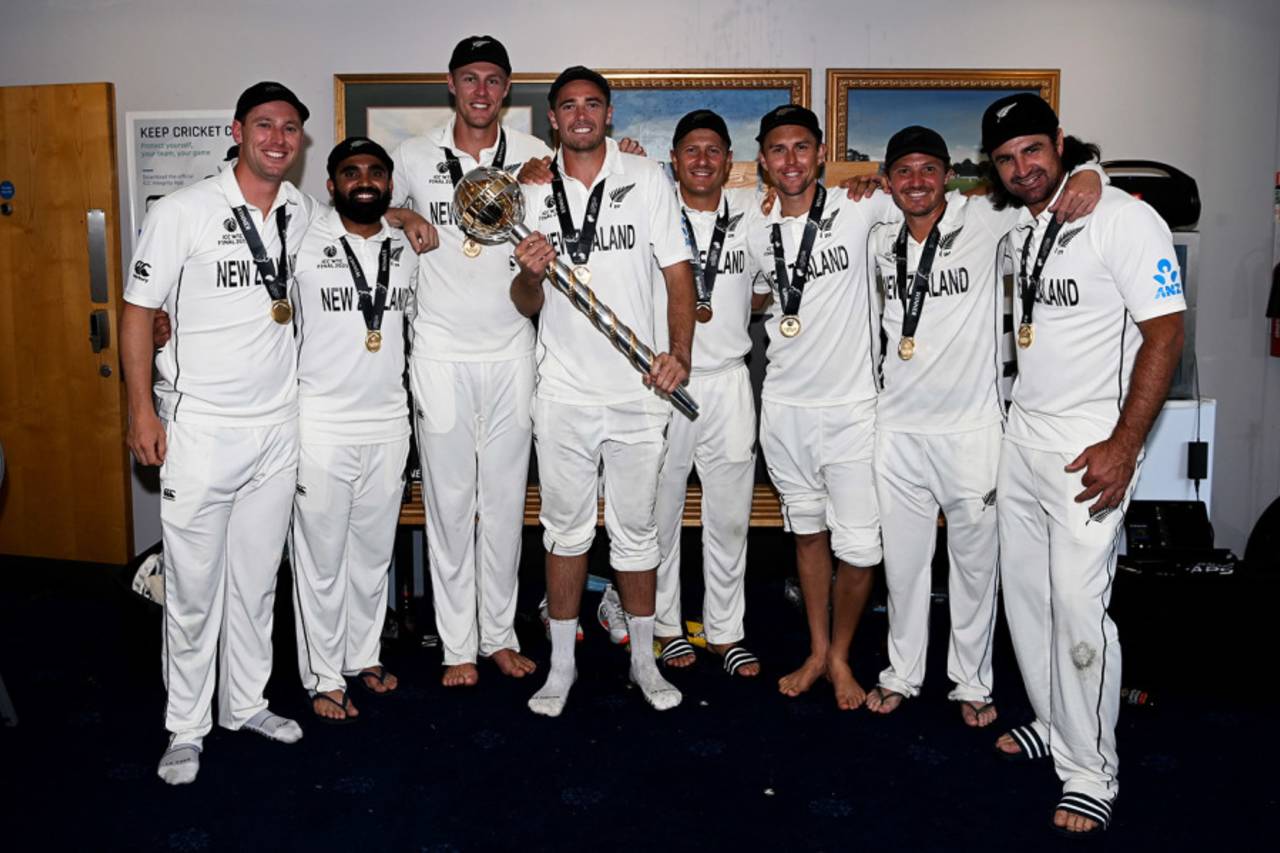How does New Zealand's pace quartet measure up against West Indies' legendary line-up?
It's rare to have a genuine fast foursome, but when you do, it's a recipe for success
Ian Chappell
04-Jul-2021

From left: Matt Henry, Ajaz Patel, Kyle Jamieson, Tim Southee, Neil Wagner, Trent Boult, keeper BJ Watling and Colin de Grandhomme with the WTC mace • Gareth Copley/ICC/Getty Images
New Zealand's well-deserved win in the World Test Championship final highlighted an accepted adage in cricket: fast bowling rules.
New Zealand's pace quartet - Tim Southee, Trent Boult, Neil Wagner and Kyle Jamieson - made possible their presence in the final. Then in the prolonged battle with India for supremacy, the quick bowlers led the last-day victory charge. Such was the influence of the New Zealand attack that there was even a comparison with the formidable West Indies quartets that ruled from the late-1970s to the mid-1990s.
To my mind, the best combination from those fearsome quartets was Andy Roberts, Malcolm Marshall, Michael Holding and Joel Garner.
If it's pace you're talking about, the West Indies quartet wins hands down. However, if you look purely at results, the New Zealand four take the prize - five matches together for a 100% winning record. That West Indies combination only played together in six matches and while never beaten, they were held to three draws.
New Zealand played four of those five matches at home and then the final at the Ageas Bowl, all favourable venues for swing and seam bowling. West Indies' three draws were all affected by inclement weather in an era when time lost was exactly that.
Statistically the leader of New Zealand's group is undoubtedly Jamieson, with 28 wickets at the uncovered-pitches-average of 12.07 in these five Tests. However experience-wise, it's swing bowler Southee who leads the way.
For the West Indies foursome, there was never any doubt about their leader - spiritually and on the rare occasion he spoke, verbally. It was Roberts who confidently assured his batters: "It doesn't matter what the opposition bowl us out for, we'll bowl them out for less."
He lived up to that promise and even though he was the veteran of that foursome, he stood out in the six matches they played together, claiming 33 wickets at the miserly average of 17.48.

Andy Roberts knocks over Brian Close's stumps at Old Trafford in 1976•PA Photos
Roberts and England's John Snow were the two best opposition fast bowlers I faced.
There haven't been many pace quartets. The concept was only made popular by West Indies captain Clive Lloyd after his team took a hammering from Australia's demon pace bowling duo of Dennis Lillee and Jeff Thomson in 1975-76. The pace quartet became standard fare for West Indies in their period of dominance but no other team has adopted the policy to that extent.
However, Australia did feature a formidable pace quartet for seven matches in the mid-1950s. Ray Lindwall, Keith Miller, Bill Johnston and Ron Archer were all genuine new-ball bowlers in their own right and operated at considerable speed.
Thanks to the presence of one genuine allrounder (Miller) and three bowling ones in Lindwall, Richie Benaud and Archer, the attack also included two spinners. This has to be one of the best balanced attacks of all time.
Pace bowling trios are more prevalent and there have been quite a few successful ones. These include Pakistan's Wasim Akram, Waqar Younis and Aaqib Javed; South Africa's Allan Donald, Shaun Pollock and Brian McMillan. Surprisingly, England didn't use Fred Trueman, Brian Statham and Frank Tyson's considerable pace in tandem; they only played together in one Test.
When it comes to high-speed threesomes, Lillee, Thomson and Len Pascoe played four Super Tests together during World Series Cricket in 1979. That would have had a speed gun whirring.
Spin bowling has been more a case of working in pairs. There have been some mighty successful ones but India did break the mould for a decade with a highly successful spin trio in Erapalli Prasanna, Bishan Bedi and Bhagwath Chandrasekhar.
While a Test match success rate of just below 30% doesn't fully reflect that trio's ability, it does hint at the advantage of the intimidation factor pace bowling provides.
In recent years India have joined the ranks of pace-bowling proficient teams. As a consequence, they have enjoyed success in Australia, reached the final of the WTC, and now have an even-money chance of beating England on their home turf.
Good pace bowling definitely has its advantages.
Former Australia captain Ian Chappell is a columnist